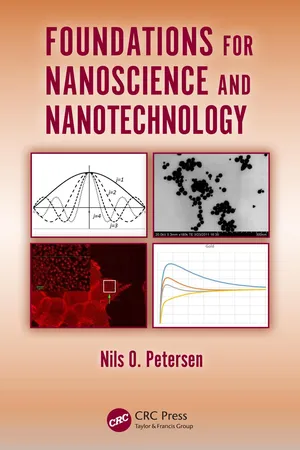
- 344 pages
- English
- PDF
- Available on iOS & Android
Foundations for Nanoscience and Nanotechnology
About This Book
Do you ever wonder why size is so important at the scale of nanosystems? Do you want to understand the fundamental principles that govern the properties of nanomaterials? Do you want to establish a foundation for working in the field of nanoscience and nanotechnology? Then this book is written with you in mind.
Foundations for Nanoscience and Nanotechnology provides some of the physical chemistry needed to understand why properties of small systems differ both from their constituent molecular entities and from the corresponding bulk matter. This is not a book about nanoscience and nanotechnology, but rather an exposition of basic knowledge required to understand these fields. The collection of topics makes it unique, and these topics include:
- The concept of quantum confinement and its consequences for electronic behaviour (Part II)
-
- The importance of surface thermodynamics for activity and interactions of nanoscale systems (Part III)
-
- The need to consider fluctuations as well as mean properties in small systems (Part IV)
-
- The interaction of light with matter and specific applications of spectroscopy and microscopy (Part V)
-
This book is written for senior undergraduates or junior graduate students in science or engineering disciplines who wish to learn about or work in the areas of nanoscience and nanotechnology, but who do not have the requisite background in chemistry or physics. It may also be useful as a refresher or summary text for chemistry and physics students since the material is focused on those aspects of quantum mechanics, thermodynamics, and statistical mechanics that specifically relate to the size of objects.
Frequently asked questions
Table of contents
- Cover
- Half Title
- Title
- Copyright
- Dedication
- Contents
- Preface
- Part I Introduction
- Chapter 1 Why study the foundations for nanoscience and nanotechnology?
- Part II Understanding quantumconfinement
- Introduction to Part II
- Chapter 2 The postulates of quantum mechanics
- Chapter 3 Time-dependent and time-independent Schrödinger equations
- Chapter 4 Solving the time-independent Schrödinger equation
- Chapter 5 Applications to systems with many electrons
- Part III Understanding surfacethermodynamics
- Introduction to Part III
- Chapter 6 The basics of thermodynamics
- Chapter 7 Surface thermodynamics
- Chapter 8 The work function
- Chapter 9 Understanding interactions between surfaces
- Part IV Understanding fluctuations insmall systems
- Introduction to Part IV
- Chapter 10 Basic statistical concepts
- Chapter 11 Partition functions
- Chapter 12 Fluctuations in closed and open systems
- Chapter 13 Measuring concentration changes
- Part V Understanding light-matterinteractions
- Introduction to Part V
- Chapter 14 The principles of absorption and emission of light
- Chapter 15 Molecular spectroscopy
- Chapter 16 Application of fluorescence microscopy
- Chapter 17 Optical properties of relevance to nanomaterials
- Chapter 18 Epilog and acknowledgments
- Part VI Problems and references
- Chapter 19 Problems
- Chapter 20 References
- Index